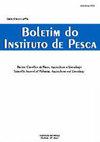基于背刺分析的西赤道大西洋鲣鱼(Katsuwonus pelamis)的年龄和生长
IF 0.6
4区 农林科学
Q4 FISHERIES
引用次数: 2
摘要
鲣鱼(Katsuwonus pelamis)是一种洄游的远洋鱼类,分布在世界上所有的热带和亚热带海洋。由于其经济重要性和捕捞努力的无限制增加,如果这种资源管理不当,种群可能会崩溃。本研究旨在根据在西赤道大西洋捕获的鲣鱼背刺的年轮,从不同的生长模型中估计生长参数。每个个体的第一个背脊被提取出来,产生0.6至0.8毫米厚的横截面。采用基于赤池信息准则(Akaike information criterion, AIC)的多模型方法选择最佳增长模型。共分析270个个体,平均体长49.58±7.72 cm。von Bertalanffy增长模型最适合数据,但Gompertz和Logistic模型也有必要的支持。观测数据和反算数据的平均渐近长度()估计分别为114.05和102.63 cm。背棘确实是估计生长参数的有效工具,多模型推理是一种新的方法,用于调整可能由单一模型方法导致的差异。本文章由计算机程序翻译,如有差异,请以英文原文为准。
Age and growth of skipjack tuna (Katsuwonus pelamis) in the western equatorial Atlantic based on dorsal spines analysis
The skipjack tuna (Katsuwonus pelamis) is a migratory pelagic fish occurring in all tropical and subtropical oceans of the world. Due to its economic importance and the unbridled increase in fishing efforts, stocks may collapse if this resource is not managed properly. The present study aimed to estimate growth parameters from different growth models based on annual rings from the dorsal spines of skipjack tuna caught in the western equatorial Atlantic. The first dorsal spine of each individual was extracted to produce cross-sections with 0.6 to 0.8 mm in thickness. We used a multi-model approach to select the best growth model based on the Akaike information criterion (AIC). Two hundred seventy individuals were analyzed, with an average length of 49.58 ± 7.72 cm. The von Bertalanffy growth model had the best fit to the data, but the Gompertz and Logistic models also had essential support. Average asymptotic length ( ) was estimated to be 114.05 and 102.63 cm for observed and back-calculated data, respectively. The dorsal spines are indeed efficient tools for estimating growth parameters and multi-model inference is a novel approach for adjusting discrepancies that likely result from a single-model approach.
求助全文
通过发布文献求助,成功后即可免费获取论文全文。
去求助
来源期刊

Boletim do Instituto de Pesca
FISHERIES-ZOOLOGY
CiteScore
0.80
自引率
0.00%
发文量
24
审稿时长
>12 weeks
期刊介绍:
To publish original articles of research and short communications in the following áreas: Fisheries, Aquaculture, Zootechnology, Limnology, Oceanography, Biology and Pathology of aquatic organisms. The publication depends on the approval of the Editorial Board, based on the peer review.
 求助内容:
求助内容: 应助结果提醒方式:
应助结果提醒方式:


